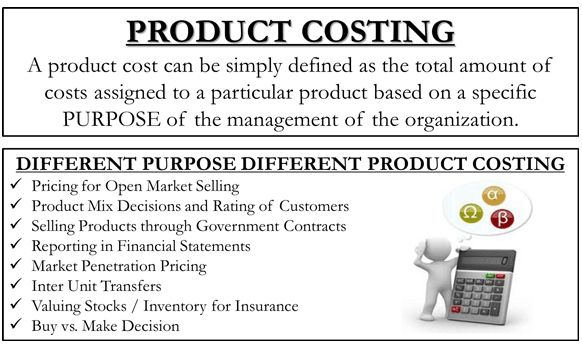Definition / Meaning
Product costing is not an absolute term having a permanent definition. The definition of product costing varies with the purpose behind costing a product. Product costing can be defined as the total amount of costs assigned to a particular product based on a specific PURPOSE of the organization’s management.
Costing is a concept not only applicable to a for-profit organization. It applies to all types of organizations involved in financial transactions and needs financial viability. The principles of costing are applicable whether we are costing a product, or service, subsidized products by government or NGOs, etc.
Example of Product Costing Under Different Purposes
Pricing for Open Market Selling
When a company does everything from scratch and sells the product on its own, the activities starting from research and development for the product, designing, manufacturing, marketing, distribution, and even customer service are undertaken for a particular product or set of products. For the costing of such a product, all the cost elements mentioned above should be assigned to the product.
Product Mix Decisions and Rating of Customers
With rising choices of products offered to consumers based on color, variance in designs, size, etc., every organization has to deal with many products. The product mix has gained a lot of importance that an efficient mix can decide a company’s bottom line. The right mix can convert a loss-making company into a profit-making one. To determine the product mix, it is necessary to have a correct product costing report to determine each product’s contribution and net margins. This can further help decide the priority of product marketing efforts and rate the customers.
Also Read: Types of Costing
Product costing in the case of determining the contribution would require following the marginal costing method and allocating all the variable costs to the products.
Selling Products through Government Contracts
Product costing in the case of selling products under a government contract is highly influenced by the guidelines issued in the contract, especially in the Cost-Plus Contracts. What costs will be reimbursed is given in their agreement, and therefore costing of products, in this case, can only allocate costs that are allowed by the government authority. Usually, expenses like marketing, distribution, customer service, R&D, etc., are either not allowed or partially allowed.
Reporting in Financial Statements
Financial reporting requires valuing the stock/inventory, and most countries’ accounting standards follow a conservative approach to valuing the stock. The rule of ‘cost or net realizable value, whichever is low, is followed. Product costing reports are prepared based on the same principle.
Market Penetration Pricing
Suppose the management decides to enter a new market or geography with its existing or new set of products and adopt a strategy of cost competitiveness. They may price the products in a way that does not even cover all the basic costs. They are intentionally pricing too low and bear the losses to follow the decided strategy and enter the target markets. The loss in the initial period they accrue due to this can even be capitalized as marketing spends just like the advertisement. Product costing for this purpose is done with a preparedness to incur a loss in selling the products initially. Once the product is accepted in the market, they may slowly increase the prices and start covering other costs which were left initially.

Inter Unit Transfers
While transferring the goods between a company’s own units as semi-finished goods or otherwise, product costing is guided by authorities levying taxes on manufactured goods for taxing purposes.
Suppose the organization recognizes its units as a separate profit center. In that case, the costs allocated while transferring the goods take care of all the costs (mostly marketing cost excluded and a portion of administration cost is allocated) and an agreed margin between the two. They try to simulate a normal market situation between the units also. (Read transfer price to learn more).
Valuing Stocks / Inventory for Insurance
When valuing the stocks/inventory in case of fire where the loss of inventory has occurred, the product costing is done based on the rules and regulations given by the insurance company. The insurance company will pass the claim only if the value is derived using their guidelines.
Buy vs. Make Decision
Often, a manufacturing concern comes across decisions of buy vs. make where they need a product as an accessory or additional product selling to same, etc. They may trade the same or manufacture themselves. Under this situation, the making decision will mostly depend on the product costing in case of making vs. if it is directly bought from the market. Product costing here will have many considerations like additional capacity enhancements, market size, the possibility of capacity utilization, existing underutilized capacity, economies of scale, etc.
Product Costing Formula
The product costing formula cannot be a universal truth. With the change in the purpose behind calculating the cost of a product, the formula will also need changes. We have observed above that with different purposes, the approach significantly changes. One same product will have a different costing formula for a different purpose.
Read Types of Costing to learn more about various types of methods of costing.

